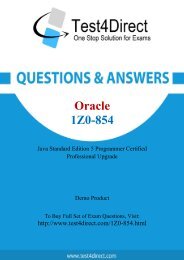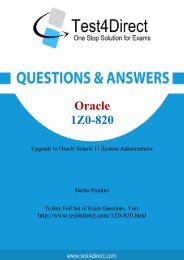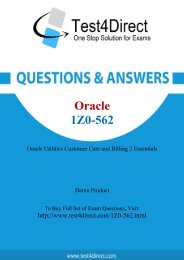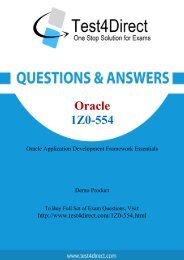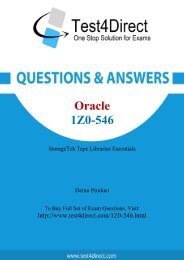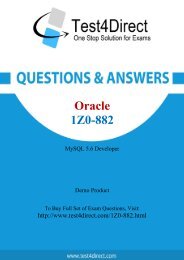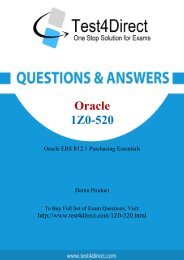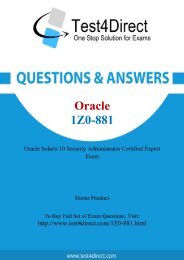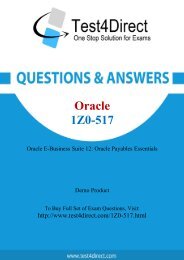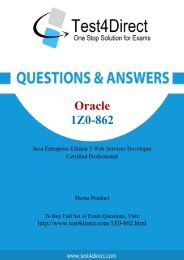1Z0-510 Latest Exam BrainDumps
Test4Direct provides latest PDF questions of Oracle 1Z0-510 exam. You have an opportunity to pass the Oracle 1Z0-510 exam in one go. Test4Direct is most accurate source to prepare Oracle 1Z0-510 exam as your success will become site’s responsibility after purchasing 1Z0-510 exam product. There are also lots of discounts and promotion offers that you can avail. Let’s try a free demo http://www.test4direct.com/1Z0-510.html
Test4Direct provides latest PDF questions of Oracle 1Z0-510 exam. You have an opportunity to pass the Oracle 1Z0-510 exam in one go. Test4Direct is most accurate source to prepare Oracle 1Z0-510 exam as your success will become site’s responsibility after purchasing 1Z0-510 exam product. There are also lots of discounts and promotion offers that you can avail. Let’s try a free demo http://www.test4direct.com/1Z0-510.html
Create successful ePaper yourself
Turn your PDF publications into a flip-book with our unique Google optimized e-Paper software.
Oracle<br />
<strong>1Z0</strong>-<strong>510</strong><br />
Oracle ATG Web Commerce 10 Implementation<br />
Developer Essentials<br />
Demo Product<br />
To Buy Full Set of <strong>Exam</strong> Questions, Visit:<br />
http://www.test4direct.com/<strong>1Z0</strong>-<strong>510</strong>.html
Question: 1<br />
Which two ASE tasks can be performed from the ACC but not the BCC?<br />
A. creating a custom product catalog<br />
B. creating targeters<br />
C. creating scenarios<br />
D. creating slots<br />
E. creating products and SKUs<br />
Question: 2<br />
Answer: C, D<br />
Explanation:<br />
Scenarios, slots, and workflows are not managed through the ATG Business Control Center (BCC). To<br />
create and edit these items, use the ATG Control Center (ACC)<br />
D: You can create slot components in two ways:<br />
By manually creating a .properties file<br />
Through the slot wizard in the ACC.<br />
Note ACC: ATG Control Center.<br />
Note BCC: The ATG Business Control Center is a browser-based interface that you use to create and<br />
edit many of the elements required to set up and maintain an ATG-based Web site<br />
Reference: ATG Business Control Center User’s Guide, Introduction<br />
Which three reasons justify why customers should choose Oracle ATG Web Commerce as their cross<br />
channel commerce platform?<br />
A. It is the most complete and integrated e-commerce solution in the market.<br />
B. It has the most flexible, modular, and elegant architecture compared to other competing solutions.<br />
C. It features production-ready reference applications that can be easily customized to meet your<br />
application requirements.<br />
D. It is the easiest platform to implement a compared e-commerce solution in the market.<br />
E. It has the best online merchandising business tools and applications of all competing solutions.<br />
Answer: A, B, D<br />
Explanation:<br />
A: To further enhance the customer experience, Oracle offers an integrated set of software-as-aservice<br />
(SaaS) commerce services that provide the flexibility and intelligence to target the right<br />
visitors at the right time with the right offer in the right channel to drive high-value sales. Through<br />
these services, your company can engage with customers at the point of interaction through<br />
personalized recommendations, targeted promotions, and guided assistance.<br />
B: Because it's built on a flexible, component-based e-commerce software architecture, ATG Web<br />
Commerce is an easily implemented best-in-class commerce solution that increases revenue,<br />
improves customer service, helps companies achieve maximum, long-term business growth, and is<br />
available as either a licensed solution or hosted on-demand solution.
D: Oracle's ATG Web Commerce Applications<br />
Oracle's ATG Web Commerce is the industry's top-ranked commerce solution that powers the world's<br />
best brands, and delivers a consistent, personalized cross-channel customer experience. ATG Web<br />
Commerce offers a complete commerce software platform that enables you to deliver a personalized<br />
customer buying experience across all customer touchpoints, including the web, contact center,<br />
mobile devices, social media, physical stores, and more.<br />
Question: 3<br />
What is the role of the allocateItemRelQuantity chain?<br />
A. to mark Shipping group as shipped<br />
B. to purchase items from pre-order, back order, or regular stock using inventory<br />
C. to reorganize Items across shipping groups<br />
D. to allocate items related to the quantity on hand<br />
Question: 4<br />
Answer: B<br />
Explanation:<br />
Note: The allocateItemRelQuantity chain is executed when called by the allocateItemRelationship<br />
chain.<br />
allocateItemRelQuantityChain<br />
This processor executes the allocateItemRelQuantity chain. After execution, execution of this chain<br />
then stops.<br />
Transactional mode: TX_MANDATORY<br />
Nucleus component: /atg/commerce/fulfillment/processor/AllocateItemRelQuantityChain<br />
PipelineProcessor object: atg.commerce.pricing.processor.ProcSendScenarioEvent<br />
Transitions: None. This is the last link in the chain and causes the PipelineManager to return to the<br />
caller.<br />
How many current and saved orders does ATG allow a user profile to have?<br />
A. ATG allows one current order and one saved order per user profile.<br />
B. ATG allows one current order and a collection of saved orders per user profile.<br />
C. ATG allows multiple current orders and a collection of saved orders per user profile.<br />
D. Only one order can exist for a Give user profile in ATG. There is no support for saved orders.<br />
Explanation:<br />
Note: loadShoppingCarts<br />
public void loadShoppingCarts(RepositoryItem pProfile,<br />
OrderHolder pShoppingCart)<br />
throws CommerceException<br />
Parameters:<br />
pProfile - the user profile<br />
pShoppingCart - the OrderHolder component for this user<br />
Throws:<br />
Answer: B
CommerceException - is any errors occur while loading the shopping carts<br />
This method finds all the shopping carts for the user and places them into the session-scope<br />
OrderHolder component. "Shopping Carts" are defined to be orders whose state is INCOMPLETE. The<br />
orders are sorted by last activity date, and the last order touched is made the current order. This<br />
method will optionally merge the current shopping cart for the session (from the<br />
OrderHolder.current property) with the first persistent order loaded from the database. This<br />
functionality is toggeled through the mergeOrders property of this form handler. NOTE: This method<br />
used to acquire a transaction lock, but we've found deadlock issues and have decided to remove the<br />
locks. See bug 146012. This method now performs its actions without a lock.<br />
Reference: atg.commerce.profile<br />
Class CommerceProfileTools<br />
Question: 5<br />
What is the reanimated order?<br />
A. INCOMPLETE orders that have not been checked out by customers and instead have remained idle<br />
for a duration of time<br />
B. Previously abandoned orders that have since been modified by the customer in some way, such as<br />
adding items or changing item quantities.<br />
C. Previously abandoned orders that have been successfully checked out by the customer.<br />
D. Abandoned orders that have been abandoned for so long that reanimation of the order is no<br />
longer considered realistic.<br />
Question: 6<br />
Answer: B<br />
Explanation:<br />
Reanimated orders<br />
– Previously abandoned orders that have since been modified by the customer in some way, such as<br />
adding items or changing item quantities.<br />
Reference: ATG Commerce Programming Guide<br />
You are creating a primary table and an auxiliary table for an Item descriptor in the versioned<br />
schema. What are the properties that must be added to the tables?<br />
A. You only need to add asset_version to both the tables.<br />
B. You need to add asset_version to both the tables. in addition, the primary table required seven<br />
other columns, such as version_editable, version_deleted, etc.<br />
C. You need to add asset_version to both the tables. in addition, the auxiliary table requires seven<br />
other columns, such as version_editable, version_deleted, etc.<br />
D. You need to add asset_version and seven other columns, such as version_editable, version<br />
deleted to both the tables.<br />
E. You need to add asset, version to the primary table and seven columns, such as version_editable,<br />
version deleted, etc. to the auxiliary tables.<br />
F. You need to add seven columns, such as version_editable, version deleted, etc. to the primary<br />
table and only asset_version to the auxiliary table.<br />
Answer: B
Explanation:<br />
Create and Install the Versioned Database Schema<br />
In order to store asset version metadata, the asset management server’s database schema requires<br />
additional columns for the primary tables used by your application’s repositories, and additional<br />
tables to store versioning information.<br />
Create the Versioned Schema<br />
To modify the asset management server’s database schema to store versioning data, follow these<br />
steps:<br />
1. Copy each database DDL file that you plan to modify.<br />
2. Add the following columns to every table that represents a primary table for an item descriptor:<br />
asset_version INT NOT NULL<br />
workspace_id VARCHAR(40) NOT NULL<br />
branch_id VARCHAR(40) NOT NULL<br />
is_head NUMERIC(1) NOT NULL<br />
version_deleted NUMERIC(1) NOT NULL<br />
version_editable NUMERIC(1) NOT NULL<br />
pred_version INT NULL<br />
checkin_date TIMESTAMP NULL<br />
3. Add the following column to every table that represents an auxiliary or multi table in an item<br />
descriptor:<br />
asset_version INT NOT NULL<br />
Reference: ATG Content Administration Programming Guide, Create and Install the Versioned<br />
Database Schema<br />
Question: 7<br />
Which component should a shareable component be registered with?<br />
A. /atg/multisite/SiteGroupManager<br />
B. /atg/multisite/SiteConfiguration<br />
C. /atg/multisite/SharedComponentConfiguration<br />
D. /atg/nucleus/multisite<br />
Question: 8<br />
Answer: A<br />
Explanation:<br />
Components are registered with the /atg/multisite/SiteGroupManager using<br />
the shareableTypes property.<br />
Reference: ATG Multisite Administration Guide<br />
If you want to update the computedCatalogs and parentCatalog properties of a product, which<br />
service should you use?<br />
A. ProductUpdateService<br />
B. CatalogGeneratorService<br />
C. AncestorGeneratorService<br />
D. ComputedCatalogService
Answer: C<br />
Explanation:<br />
The AncestorGeneratorService component generates ancestor categories for the product and<br />
category item types, and stores the names of these ancestor categories in the ancestorCategories<br />
property of each product and category.<br />
The AncestorGeneratorService updates the following property values for each of the catalog item<br />
types. This service must be executed after making catalog updates in order for catalog navigation and<br />
search to work correctly.
THANKS FOR TRYING THE DEMO OF OUR PRODUCT<br />
Visit Our Site to Purchase the Full Set of Actual <strong>1Z0</strong>-<strong>510</strong> <strong>Exam</strong> Questions With Answers.<br />
http://www.test4direct.com/<strong>1Z0</strong>-<strong>510</strong>.html<br />
We Also Provide Practice <strong>Exam</strong> Software That Simulates Real <strong>Exam</strong> Environment And Has<br />
Many Self-Assessment Features. Download Free Product Demo From:<br />
http://www.test4direct.com/<strong>1Z0</strong>-<strong>510</strong>.html<br />
Money Back Guarantee<br />
Check Out Our Customer Testimonials






